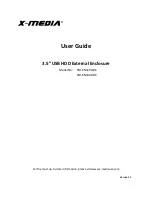
Goliath™ Series IV
swrsound.com
Congratulations on your purchase of a Goliath™ bass speaker
enclosure! The original Goliath 4x10 made history in 1987 as the first
bass cabinet with true, full-range bass response and a tweeter horn
– a radical concept at the time, but imitated so often that it is now
an industry standard. In fact, we here at SWR® have been putting
everything we know about bass into our product line since 1984,
and we’ve earned a reputation for designing and manufacturing gear
that has changed the way bassists hear themselves –establishing
many other industry standards along the way. That’s why you’ll find
our bass amps, speaker enclosures, and combos on stages and in
recording studios around the world – and why you’ll hear SWR on
countless recordings, spanning all genres of music.
The Goliath (Series IV) speaker enclosures are designed for today’s
powerful bass amplification systems and feature the highest power
handling capabilities ever offered by SWR, while maintaining the
crystal-clear, full-range tone that is unmistakably SWR. Inside this
owner’s manual you will find specifications, features, and usage
suggestions for every Goliath bass speaker enclosure we build. Please
take the time to look through this brief but informative manual
before plugging in and playing, and thank you for "stepping up" to
SWR!
IMPORTANT INFORMATION
• ONLY connect one amplifier to your bass speaker
enclosure(s). Two amplifier outputs connected together
may damage your equipment.
• DO NOT connect speakers with a total impedance load
below the minimum rating of your amplifier to prevent
damage to your equipment. See
Impedance Guidelines
.
• DO NOT connect speakers with a total power handling
capacity that is below the power output rating of your
amplifier to prevent damage to your speakers.
• ALWAYS switch your system power OFF before connecting
or disconnecting speakers.
• ONLY use unshielded speaker cable of 18 gauge or heavier
(such as 16 or 14 gauge) for speaker connections. Shielded
instrument cable may limit the power delivered to your
speaker and the cable may overheat.
• SWR RecOmmeNDS removing any casters from bass
speaker enclosures during performance to extend your bass
response by coupling the enclosure more closely to the
floor.
IMPEDANCE GUIDELINES
Use the impedance ratings on your amplifier and speakers
to determine if a particular combination of speakers is
appropriate for your amplifier. NOTe: All SWR® bass speaker
enclosures (and most others) are wired in parallel (not in
series), therefore, these
Impedance Guidelines
apply only to
parallel speaker connections.
This Illustration shows the total
impedance loads of various
combinations
of
speakers
connected in parallel. Ideally,
you will want to connect your
amplifier to speakers with a total
impedance load equal to the
minimum impedance rating of
your amplifier. Operating below
the minimum impedance rating
can easily overheat the amplifier
and cause damage. conversely,
operating above the minimum
impedance rating will reduce
the amplifier’s maximum power
output capability.
Notice that different combinations
of speaker impedances can equal the same total impedance
load. If speaker impedances are alll the same in a group,
each speaker will receive equal power from your amplifier.
However, if speaker impedances are
not
the same, speakers
with the lowest impedances will receive the most power. For
example, if 4Ω and 8Ω speakers are connected in a group,
the 4Ω speaker will draw double the power and may be
louder than the 8Ω speaker. Take this into consideration when
calculating power handling capacities and when positioning
your bass speaker enclosures.
Set–Up and Operation
Summary of Contents for Goliath
Page 25: ...Notes swrsound com 25 ...
Page 26: ...Notes swrsound com 26 ...
Page 27: ...Notes swrsound com 27 ...





































